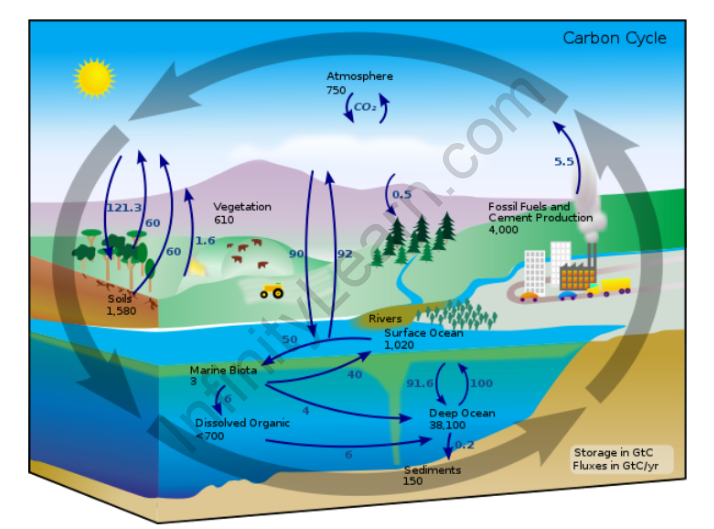Table of Contents
What is carbon cycle?
The carbon cycle is a crucial process that regulates the movement of carbon between the atmosphere, land, and oceans. It plays a vital role in maintaining the balance of carbon dioxide (CO2) in the Earth’s atmosphere, which is essential for sustaining life on our planet. Let’s explore the carbon cycle, its steps, land and oceanic components, and its significance.
Definition of Carbon Cycle
The carbon cycle refers to the continuous movement of carbon through various reservoirs, including the atmosphere, living organisms, soil, oceans, and rocks. It involves the exchange of carbon between these reservoirs through different processes.
Diagram of Carbon Cycle

Steps of the Carbon Cycle
- Carbon Fixation: Green plants and algae use photosynthesis to convert atmospheric CO2 into organic carbon compounds, such as glucose, which becomes part of their biomass.
- Respiration: Both plants and animals release CO2 into the atmosphere through respiration, the process by which they convert organic matter into energy.
- Decomposition: When plants and animals die, their organic matter decomposes. During decomposition, carbon is released back into the atmosphere as CO2 through the actions of decomposer organisms.
- Combustion: Burning fossil fuels, such as coal, oil, and natural gas, releases carbon stored in them into the atmosphere as CO2. Human activities like burning forests also contribute to carbon emissions.
- Carbon Sequestration: Carbon can be stored in long-term reservoirs, such as forests, soil, and oceans. Plants absorb CO2 from the atmosphere during photosynthesis and store it as carbon in their tissues. This process is known as carbon sequestration.
Also Check
Types of Carbon Cycle
There are two types of carbon cycle Land carbon cycle and Oceanic carbon cycle.
Land Carbon Cycle
On land, plants play a crucial role in the carbon cycle. Through photosynthesis, they absorb CO2 from the atmosphere, converting it into organic compounds. This carbon is then passed on to herbivores that consume plants. When plants and animals die, their organic matter decomposes, releasing CO2 back into the atmosphere or getting stored in the soil.
Oceanic Carbon Cycle
The oceans act as significant carbon sinks. They absorb CO2 from the atmosphere through a process called oceanic uptake. This absorbed carbon can then be used by marine organisms for growth. When marine organisms die, their remains sink to the ocean floor, where carbon can be stored for long periods in the form of sediment.
Importance of the Carbon Cycle:

- Regulation of Climate: The carbon cycle helps regulate Earth’s climate by controlling the concentration of CO2 in the atmosphere. Carbon dioxide is a greenhouse gas that traps heat and contributes to global warming.
- Sustaining Life: Carbon is a fundamental element for all living organisms. The carbon cycle ensures the availability of carbon for the growth and development of plants, animals, and microorganisms.
- Carbon Storage: The carbon cycle plays a vital role in carbon sequestration, helping to mitigate the impacts of rising CO2 levels. Forests, oceans, and soil act as significant carbon sinks, storing carbon for extended periods.
Key Points:
- The carbon cycle involves the movement of carbon between the atmosphere, land, and oceans through various processes.
- Green plants and algae convert atmospheric CO2 into organic carbon compounds through photosynthesis.
- Respiration, decomposition, and combustion release carbon back into the atmosphere.
- Land and ocean ecosystems act as carbon sinks, sequestering and storing carbon.
- The carbon cycle helps regulate climate, sustains life, and plays a crucial role in carbon storage and sequestration.
In conclusion, understanding the carbon cycle is essential for comprehending the movement of carbon and its impacts on our planet. The carbon cycle is a complex yet interconnected process that influences Earth’s climate, sustains life, and offers
Frequently asked questions on Carbon Cycle
What is the carbon cycle?
The carbon cycle refers to the continuous movement of carbon between the atmosphere, land, and oceans through various processes.
What are the steps involved in the carbon cycle?
The steps of the carbon cycle include carbon fixation, respiration, decomposition, combustion, and carbon sequestration.
How does carbon enter the atmosphere?
Carbon sequestration is the process by which carbon is stored long-term in reservoirs such as forests, soil, and oceans, helping to mitigate the effects of increasing carbon dioxide levels in the atmosphere.
How do plants contribute to the carbon cycle?
Plants absorb carbon dioxide from the atmosphere during photosynthesis, converting it into organic compounds and releasing oxygen as a byproduct.
What role do oceans play in the carbon cycle?
The oceans act as a significant carbon sink, absorbing carbon dioxide from the atmosphere through a process called oceanic uptake. They also support marine life, which plays a role in the cycling of carbon.
How does human activity impact the carbon cycle?
Human activities, such as burning fossil fuels and deforestation, release large amounts of carbon dioxide into the atmosphere, contributing to the increase in greenhouse gas levels and affecting the carbon cycle.
Why is the carbon cycle important for the environment?
The carbon cycle helps regulate Earth's climate by controlling the concentration of carbon dioxide in the atmosphere. It also sustains life by providing carbon for the growth and development of plants, animals, and microorganisms.
How does the carbon cycle relate to climate change?
The carbon cycle is closely tied to climate change as the increased release of carbon dioxide from human activities disrupts the natural balance, leading to global warming and associated environmental impacts.







